View in other NatureServe Network Field Guides
NatureServe
Montana
Utah
Wyoming
Idaho
Wisconsin
British Columbia
South Carolina
Yukon
California
New York
Black Sandshell - Ligumia recta
General Description
The Black Sandshell is the largest mussel found in the Missouri and Milk river systems. It has a very heavy, large long-elliptical black shell (up to 10 inches) with a pinkish to purple nacre. It is likely an introduced species to Montana because it was not found or reported before the 1970's and now appears to be relatively abundant and increasing it's range up the Missouri River, but not in the Yellowstone River.
Diagnostic Characteristics
"Shell up to about 175 mm long, 75 mm high, 45 mm wide (males) and with mid-anterior shell wall about 8 mm thick. Females are proportionately broader, especially posteriorly. Shell long-elliptical, roundly pointed posteriorly in males, evenly rounded posteriorly in females, thick and strong. Surface smooth except for concentric wrinkles and growth rests. Periostracum dark green, dark brown or nearly black, and with darker rays that are obscure in adults. Nacre silvery white throughout, or partially to wholly purple or pink. Beak sculpture faint, obsolete, and consisting of 3 to 5 indistinct double-looped bars that disappear on the posterior slope. Hinge teeth well developed and strong: pseudocardinal teeth conical, elevated, serrated, 1 or 2 in the right valve and 2 in the left; lateral teeth long, also elevated 1 in the right valve and 2 in the left. Easily recognized by its large size, lance-head shape, well-developed hinge teeth, and almost black colour." (Clarke 1981:334).
Species Range
Montana Range
Range Descriptions
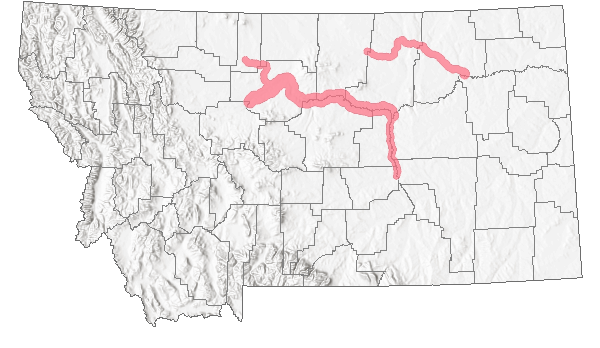
 Non-native
Non-native
Range Comments
This species is the largest mussel found in the Missouri and Milk river system. We have records in the Missouri River from Fort Benton downstream to the Yellowstone River Confluence, upstream into the Musselshell and Milk Rivers, probably spreading from a Fort Peck Reservoir introduction. Recent surveys in 2009 documented this species moving upstream into the Marias River as well. Outside of Montana this is a widespread species in the central and eastern parts of the continent. Until the 1970's there were no known records for Montana (La Rocque 1967:268). This lends credence to the theory that these are recent introductions to Montana as well. Burch's range comment indicate that this species extends as far west as North and South Dakota and occurs throughout the Missouri/Mississippi River drainage. Burch (1975:20) records the species for the Mississippi drainage from Pennsylvania to Minnesota and south to Oklahoma and Alabama; also in the Canadian Interior Basin in Lake Winnipeg and the Red River systems (Clarke 1973a).
Observations in Montana Natural Heritage Program Database
Number of Observations: 72
(Click on the following maps and charts to see full sized version)
Map Help and Descriptions
Relative Density
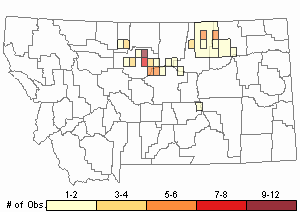
Recency
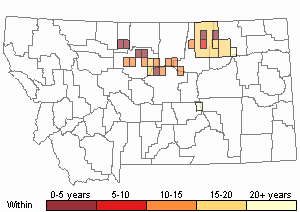

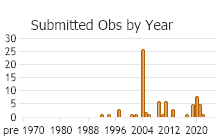
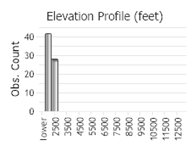 (Observations spanning multiple months or years are excluded from time charts)
(Observations spanning multiple months or years are excluded from time charts)
Migration
Adult freshwater mussels are mostly sedentary and spend their lives near the area where they first settled as juveniles. They will move short distances (a few meters) during spawning or if prompted by a stimulus such as a water disturbance nearby, exposure due to low water, or seasonal temperature changes. They may burrow into sediments (often doing so in the fall and emerging in the spring) or move away from the area horizontally. Most dispersal takes places through there host fish, especially the spring/summer movements of their host fish walleye and sauger.
Habitat
The species usually occurs in large rivers but is also found in large lakes and canals. It is generally found on sand and gravel bottoms, but occasionally on mud (Clarke 1981:334). In Montana, this species was found in areas with higher percentage of cobble/pebble than co-occuring fatmuckets in the Missouri, Milk and Marias River systems and never in silted areas (Stagliano 2009)
Food Habits
Freshwater mussels are mostly filter-feeders, siphoning in floating particulate organic materials (small plant or animal) from the water column and straining out the particles and expel the strained water. Pedal feeding with the foot muscle has also been observed, mostly in juveniles and younger age-classes.
Ecology
Known host fish species include the native Sauger and introduced species: the Walleye and some centrarchids (sunfish).
Reproductive Characteristics
"A long-term breeder; its gravid period overlaps in different individuals and extends from June, July and August through the winter to the following summer. The glochidia are purse-shaped, ovate, and measure about 0.23 mm long and 0.27 mm high. The known fish hosts include the native sauger and introduced centrarchids (bluegill, largemouth bass, and white crappie) (Clarke 1981:334).
Stewardship Responsibility
Threats or Limiting Factors
Threats to freshwater mussels and their habitats are thought to include: Pollution, Diversion of rivers for irrigation, hydroelectric and water supply projects, Elimination of natural fish hosts and eutropification due to agricultural runoff and urbanization
References
- Literature Cited AboveLegend:
 View Online Publication
View Online Publication Burch, J.B. 1975. Freshwater unionacean clams (Mollusca: Pelecypoda) of North America: Biota of Freshwater Ecosystems, Identification Manual No 11. Environmental Protection Agency, Washington, D.C. 176 pp.
Burch, J.B. 1975. Freshwater unionacean clams (Mollusca: Pelecypoda) of North America: Biota of Freshwater Ecosystems, Identification Manual No 11. Environmental Protection Agency, Washington, D.C. 176 pp. Clarke, A.H. 1981. The freshwater molluscs of Canada. National Museum of Natural Sciences, National Museums of Canada, Ottawa. 446 pp.
Clarke, A.H. 1981. The freshwater molluscs of Canada. National Museum of Natural Sciences, National Museums of Canada, Ottawa. 446 pp. La Rocque, A. 1967. Pleistocene Mollusca of Ohio. Department of Natural Resources, Division of Geological Survey Bulletin 62, Part 2. 113-365 + 8 plates.
La Rocque, A. 1967. Pleistocene Mollusca of Ohio. Department of Natural Resources, Division of Geological Survey Bulletin 62, Part 2. 113-365 + 8 plates. Stagliano, D.M. 2009. Data from aquatic mussel sampling for the SWG Freshwater Mussel Project
Stagliano, D.M. 2009. Data from aquatic mussel sampling for the SWG Freshwater Mussel Project
- Web Search Engines for Articles on "Black Sandshell"
- Additional Sources of Information Related to "Mussels / Clams"





